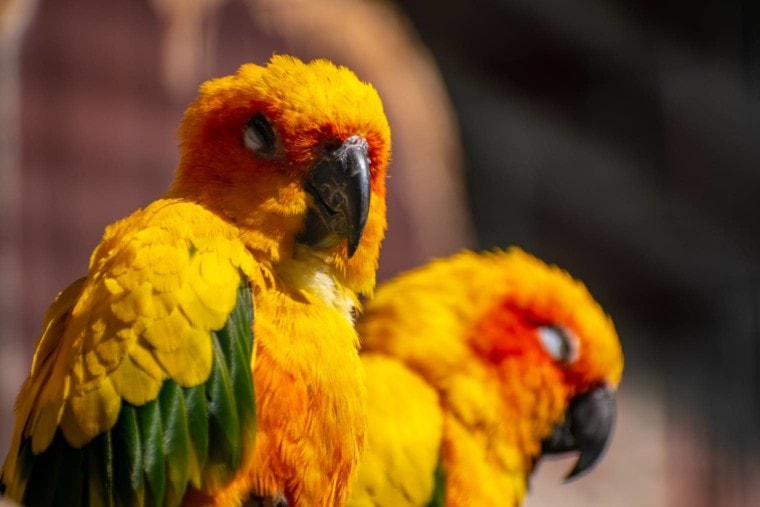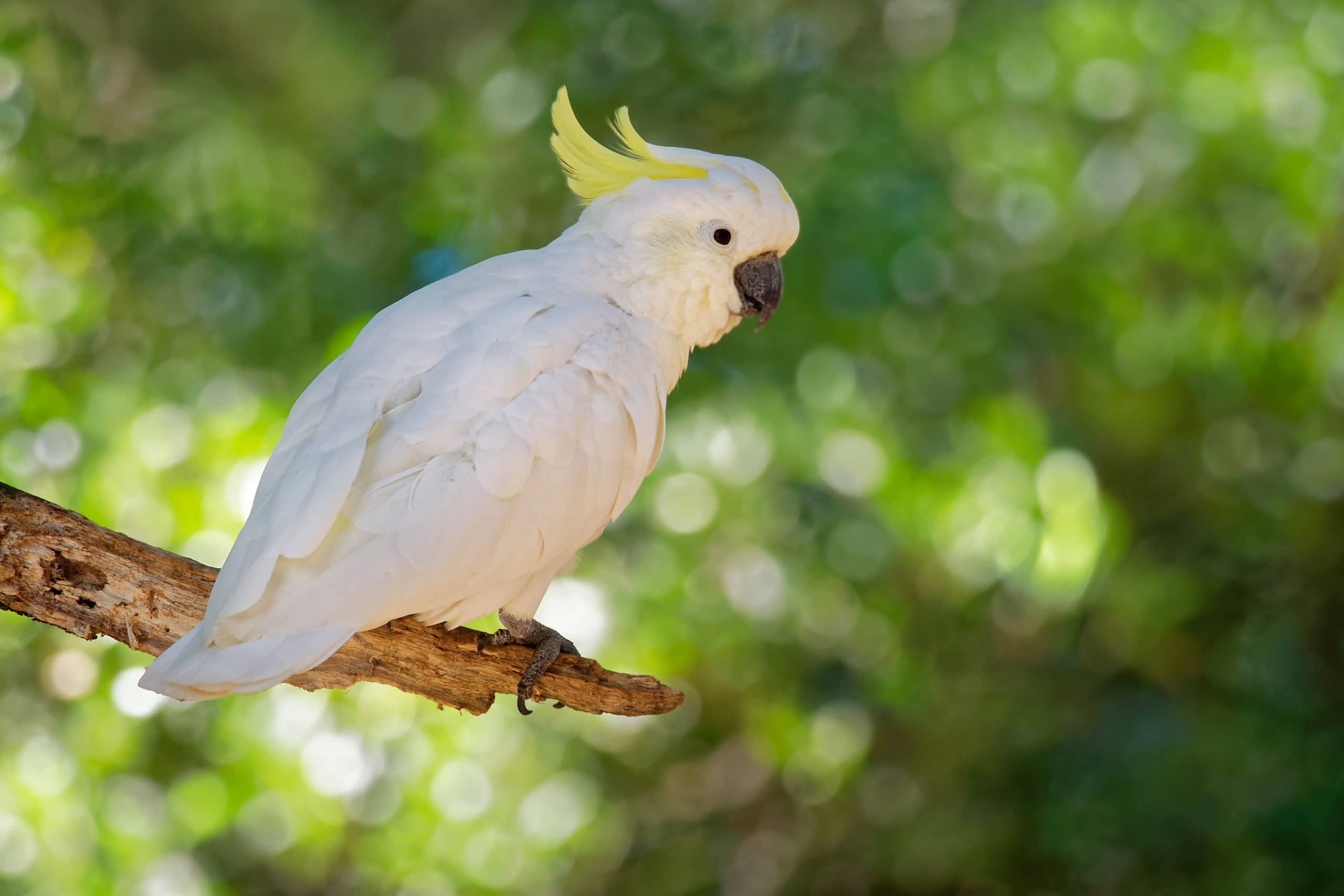
If you associate wild parakeets with steamy jungle habitat, it might surprise you to learn that parakeets were once found in the not-so steamy forests of Iowa. Yes, America was once home to its own native species of parakeet, the Carolina parakeet. Unfortunately, these colorful birds are now extinct not only in the wild but in captivity as well. In this article, we’ll learn more about the Carolina parakeet, what they looked like, and why they became extinct.
 Species Overview
Species Overview
| Common Names: | Carolina parakeet, Carolina conure |
| Scientific Name: | Conuropsis carolinensis, Subspecies: C.c. carolinensis, C.c. ludovicianus |
| Adult Size: | 13 inches |
| Life Expectancy: | 30-35 years in captivity |
Origin and History
Carolina parakeets were present on the North American continent for thousands of years before European settlers first arrived. They were a common sight throughout their range during the early days of America. In the 18th and 19th centuries, these birds were found in swamps and wetlands of the Southeast and forested river valleys of the Midwest.
Carolina parakeets were the northernmost known species of parakeet. Their range is thought to have been as far north as Pennsylvania and as far west as Nebraska. It’s believed their closest relatives were the Aratinga parakeets of Central and South America. The number of wild Carolina parakeets declined during the 19th century and the last known wild bird was killed in 1904. In 1918, the last of the Carolina parakeets died in captivity at a zoo.
Behavior In The Wild
Carolina parakeets are believed to have been highly social birds. At the height of their population, flocks of 200-300 birds were often seen foraging and feeding together. These parakeets spent mostly early morning and early evening hours hunting for food, sometimes over long distances.
It’s thought that Carolina parakeets nested in hollowed-out areas of large trees, often taking over old woodpecker homes. Carolina parakeet pairs most likely mated for life. Reportedly, several female Carolina parakeets laid their eggs in the same nest, a rare behavior for parakeets. Baby Carolina parakeets required a high level of care from their parents, even after they could fly and leave the nest.
Speech & Vocalizations
Carolina parakeets were noisy and vocal birds, as are most parakeet species still in existence. Their loud calls, most accurately described as screeching, were useful in allowing the often spread-out flocks of parakeets to communicate over long distances. Because the flocks were so large, individual parakeets also vocalized to help find their mates or young among the crowd.
 Carolina Parakeet Colors and Markings
Carolina Parakeet Colors and Markings
Carolina parakeets were colorful birds with primarily green bodies, darker on top and lighter underneath. Their necks and the tops of their wings were bright yellow while their heads and faces were reddish-orange. Both their legs and their beaks were pale white. Males and females were the same in color, but males were often a bit larger.

Diet and Nutrition
Seeds, buds, and fruits of various trees and grasses were the primary food sources of the Carolina parakeet. One favorite food of these parakeets was the cocklebur, which is toxic to many other animals. Rumor has it that this toxic food may have made the Carolina parakeets themselves poisonous to predators like cats.
Carolina parakeets also gained valuable nutrients by drinking salt water and eating salty soil along riverbanks. Wild macaws and other species show similar behavior today.
As the natural habitat and food sources of the Carolina parakeet fell victim to the rapidly expanding settlements of humans, the birds began feeding on human crops and orchards. Unfortunately, this caused farmers to view Carolina parakeets as a nuisance and begin hunting them down.
Why Carolina Parakeets Became Extinct
After extensive research, scientists have concluded that a combination of factors led to the extinction of the Carolina parakeet. Unfortunately, humans played a role in all of them.
Loss of habitat was one of the biggest culprits leading to the decline of the Carolina parakeet. Widespread clearing of forests caused the birds to lose their nesting spots and much of their natural food sources. Carolina parakeets can’t reproduce quickly, to begin with, and their job got that much harder without enough space to nest.
As Carolina parakeets were forced to find new food supplies, they turned to plentiful human farms. This foraging of human settlements made them targets for farmers, who protected their crops by killing off the colorful intruders. Carolina parakeets were easy to shoot in large numbers because their natural instincts led them to gather in large flocks around any wounded birds.
Other factors contributing to the extinction of Carolina parakeets include the capture of birds to keep as pets and likely the spread of disease caught from domestic poultry. Settlers also introduced honeybees into the parakeets’ home range, causing additional loss of nesting space as bees took over hollow trees for hives.
Could The Carolina Parakeet Ever Come Back?
Actually, this isn’t entirely out of the question. Though there are no living Carolina parakeets, many skeletons and mounted specimens remain in museums worldwide. As part of the research into why the birds went extinct, scientists mapped their entire genetic code.
Based on that code, scientists believe that the sun parakeet (sun conure) is the closest living relative of the Carolina parakeet. All this information makes Carolina parakeets a possible candidate for “de-extinction.” While the process would be long and complicated, scientists could, in theory, manipulate the genetics of sun parakeets by introducing DNA from Carolina parakeets.
Eventually, the goal would be to be able to reintroduce Carolina parakeets into their old habitat. While more research is needed into this possibility, the potential for one day seeing wild parakeets in the forests of Iowa again isn’t as far-fetched as you might think.
Summary
Sadly, humanity failed to learn its lesson from the extinction of the Carolina parakeet. Today, wild parrots and parakeets remain some of the most endangered species in the world. Many of the same factors that led to the demise of the Carolina parakeets are threatening modern wild birds, especially the loss of habitat.
The illegal wild pet trade is another major source of population decline in the wild. If you are a lover of exotic birds, you can help save more species from going the way of the Carolina parakeet. Only buy captive-bred pet birds from reputable sources to avoid supporting the illegal pet trade. If you are able, consider donating to organizations working to save wild birds and their habitat.
Featured Image Credit: Wirestock Creators, Shutterstock

 Species Overview
Species Overview Carolina Parakeet Colors and Markings
Carolina Parakeet Colors and Markings





